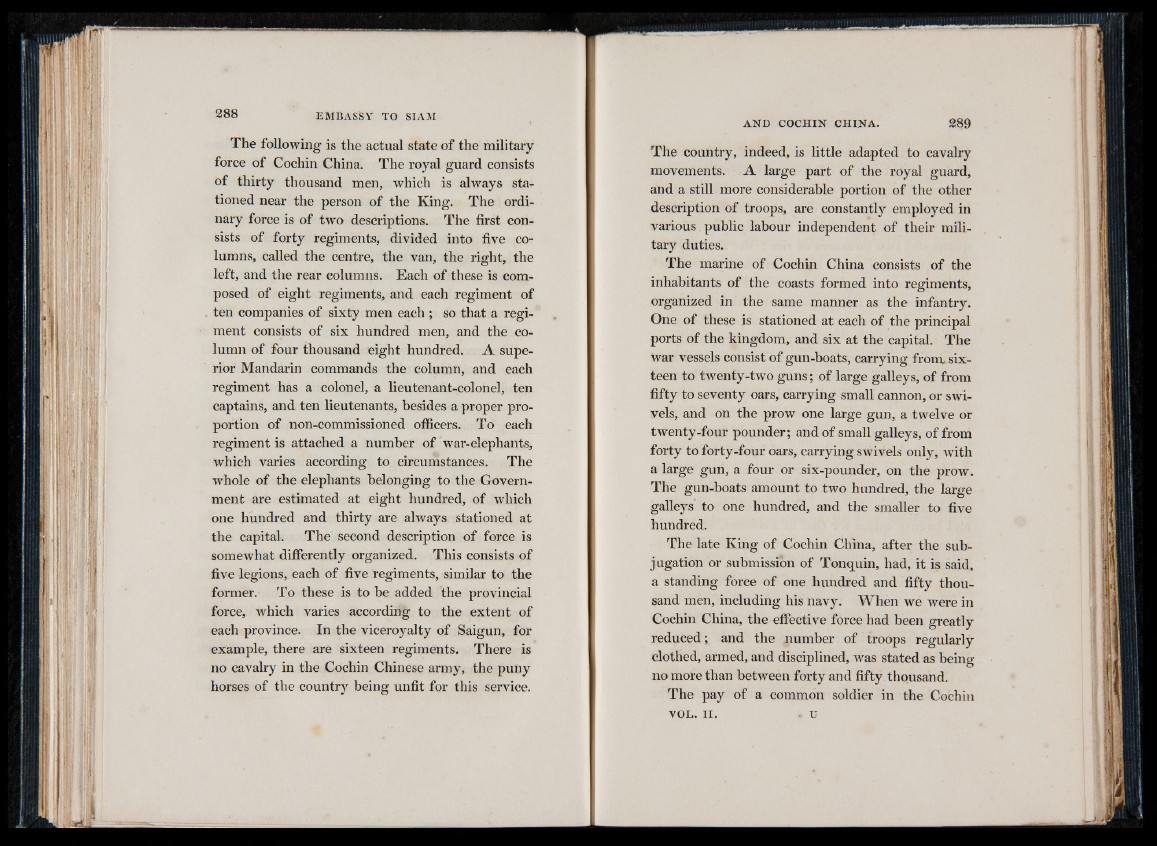
The following is the actual state of the military
force of Cochin China. The royal guard consists
of thirty thousand men, which is always stationed
near the person of the King. The ordinary
force is of two descriptions. The first consists
of forty regiments, divided into five columns,
called the centre, the van, the right, the
left, and the rear columns. Each of these is composed
of eight regiments, and each regiment of
ten companies of sixty men each ; so that a regiment
consists of six hundred men, and the column
of four thousand eight hundred. A superior
Mandarin commands the column, and each
regiment has a colonel, a lieutenant-colonel, ten
captains, and ten lieutenants, besides a proper proportion
of non-commissioned officers. To each
regiment is attached a number of war-elephants,
which varies according to circumstances. The
whole of the elephants belonging to the Government
are estimated at eight hundred, of which
one hundred and thirty are always stationed at
the capital. The second description of force is
somewhat differently organized. This consists of
five legions, each of five regiments, similar to the
former. To these is to be added the provincial
force, which varies according to the extent of
each province. In the viceroyalty of Saigun, for
example, there are sixteen regiments. There is
no cavalry in the Cochin Chinese army, the puny
horses of the country being unfit for this service.
The country, indeed, is little adapted to cavalry
movements. A large part of the royal guard,
and a still more considerable portion of the other
description of troops, are constantly employed in
various public labour independent of their military
duties.
The marine of Cochin China consists of the
inhabitants of the coasts formed into regiments,
organized in the same manner as the infantry.
One of these is stationed at each of the principal
ports of the kingdom, and six at the capital. The
war vessels consist of gun-boats, carrying from, sixteen
to twenty-two guns; of large galleys, of from
fifty to seventy oars, carrying small cannon, or swivels,
and on the prow one large gun, a twelve or
twenty-four pounder; and of small galleys, of from
forty to forty-four oars, carrying swivels only, with
a large gun, a four or six-pounder, on the prow.
The gun-boats amount to two hundred, the large
galleys to one hundred, and the smaller to five
hundred.
The late King of Cochin China, after the subjugation
or submission of Tonquin, had, it is said,
a standing force of one hundred and fifty thousand
men, including his navy. When we were in
Cochin China, the effective force had been greatly
reduced; and the number of troops regularly
clothed, armed, and disciplined, was stated as being
no more than between forty and fifty thousand.
The pay of a common soldier in the Cochin
VOL. I I . <, u